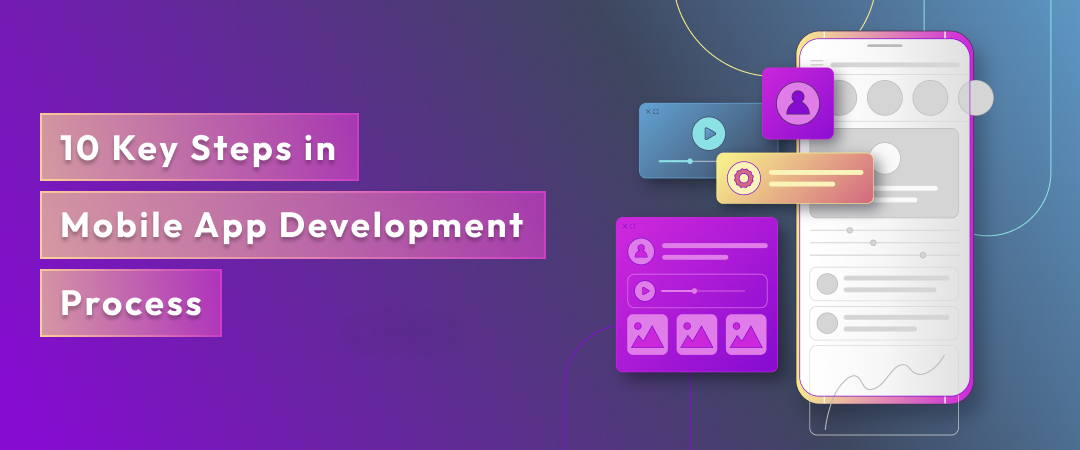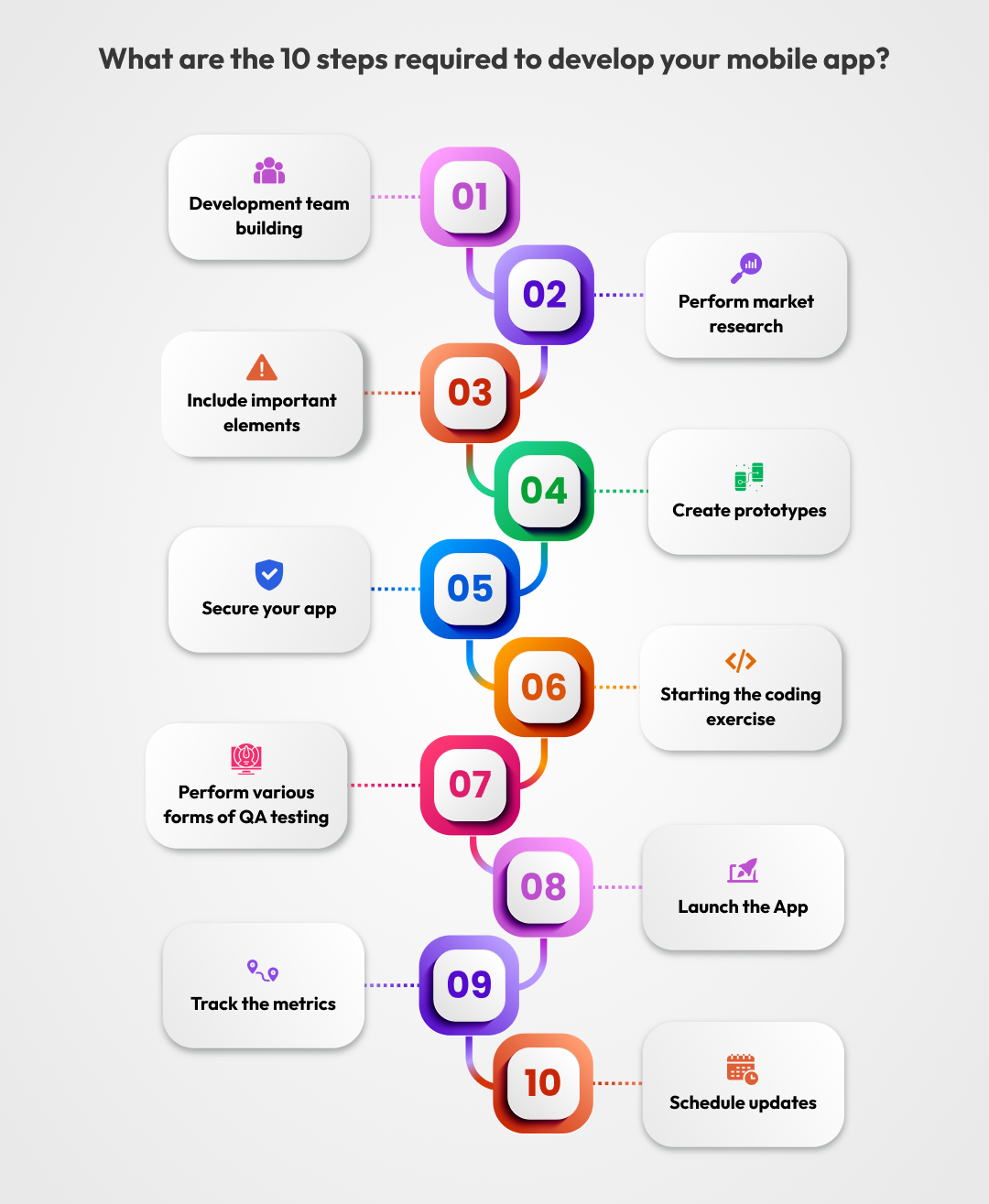
What are the 10 Steps to Successfully Developing a Mobile App

Smartphones have become indispensable in today’s life, and users started utilizing them immensely to simplify their daily needs. Each day a new app is launched in an already saturated market. Yet, all business activities mandate mobile app development to stay relevant in the market. Each entrepreneur is prepared to put money into developing a market niche for their product.
Therefore, developing a mobile app is time-consuming, and the ideal blend is needed to provide an audience with an appealing design, adaptable navigation, unbreakable security, sophisticated features, and reasonable pricing.
What are the 10 steps required to develop your mobile app?
The African proverb “It takes a village to raise a child” also applies to the time-consuming nature of application development. Numerous technical procedures and protocols, the participation of technical teams, the goals of management teams, and external factors influence the overall development of the app. In a nutshell, we’ve listed the steps you need to take to create your mobile application below.

Let us go through it together:
Step1. Development team building:
Developing an app is now easier with the various online software programs. However, it takes the cooperation of a multifaceted development team with sound subject matter expertise to establish a solid mobile application. This team-building effort helps to employ individuals with distinct skill sets for your project.
The development team’s mandatory requirements are:
- Product manager – To create technical specifications, roadmaps, and timelines and oversee them through completion.
- UX/UI designer – Responsible for the aesthetics, graphics, and functionalities that draw users in.
- Mobile developer – For integrating APIs, coding functionality, and other uses.
- Quality assurance analyst – To perform tests at different stages to avoid technical issues and bugs before releasing the app onto the market.
- Digital marketer – To help you launch the app successfully and use blogs and search engine optimization (SEO).
Freelance hiring is also advised, depending on your mobile app’s financial stability and additional features.
Step 2. Perform market research:
The app market is inundated with 2.20 million apps for Apple users and 3.40 million for Android users. Knowing your competitors’ products’ uniqueness and customer requirements helps make a competitive product amongst its peers.
The research needs to focus on a few things:
- Competitors app – the aspects where they excelled and places where they fell short of expectations.
- Customers’ needs – understanding their preferences, age group, and what they anticipate from the app (unique features).
- Understanding market demands – enables you to address market needs for problem-solving through your app.
- Feedback time – is required from users. Conduct interviews with the target audience’s customers. Creating new features that meet their needs gives you an advantage over your rivals.
Step 3. Include important elements:
You gain an advantage from the compiled market research by learning what the market is currently catering to, what components are lacking, and what the target users are looking for. The core features can be developed based on what is ignored.
Most of the time, mobile app developers make straightforward, user-friendly apps that are simple to navigate. List additional features that help deliver uniqueness and innovation along with the prerequisites. They include speed, good image resolution, and security.
A few additional features to add are:
- Cross-platform functioning – that is compatible with both operating systems.
- Search option – when the app is designed for e-commerce and social media.
- Push notification and social media sharing links.
- Facial recognition for log-in facilities provided you have a budget to cover it.
Once the app is live, leave yourself enough room to add new features or frequent updates.
Step 4. Create prototypes:
The user interface (UI) and User experience (UX) designer must develop a mock-up or prototype once the requirements are collected, and critical features are outlined. A mock-up’s purpose is to give the development team a taste of their product’s functionality and the app’s appearance (colour, typography, and images).
The benefits of a mock-up are:
- The app’s appearance can be revised if the management is dissatisfied.
- Before beginning actual coding, investors can view the product and its features.
- The development team takes suggestions and criticism seriously and works to implement all workable ones.
- The app receives updates regularly based on user feedback.
Step 5. Secure your app:
Security features are the next step that is crucial for any app-building mechanism. For your app to maintain its goodwill and reputation over time, you must keep cybercriminals at bay and secure your data. Trespassing in any form will have an effect, harming your company’s reputation and causing financial loss.
The platforms and mobile apps’ security features are implemented using the following:
- Data encryption – is necessary to secure confidential personal data in your app’s software. The use of encryption for the local database, cache, and API communication is encouraged.
- API Authorization – is a vital part of back-end programming. Therefore, ensure to utilize an API for your application that meets the platform’s standards where your app is present.
- Periodic testing – is the weapon to identify the security flaws in your coding system. Therefore, consistently review your code as it is being developed. It is much preferable to find a potential security hole before the app is released rather than waiting for a hacker to do so.
- Tamper detection software – helps prevent hackers from attempting. An efficient solution is integrating an impenetrable security feature into the application, such as tamper-detection software and other third-party software. Software designed specifically for Apple and Android exists to stop these strategies.
Step 6: Starting the coding exercise:
Coding components consist of front-end and back-end. Front-end development is intended for the users’ experience, while back-end development determines the app’s functionality. Team coordination is required as developers will be working from both ends. Using Agile methodology helps in project management due to flexible and efficient coding.
Having your team code in a test environment before completing the app is always recommended. The test environment infrastructure includes a database server, a front end, operating systems, and networks. A bug reporting tool is required to ensure accurate and granular test data.
Step 7: Perform various forms of QA testing:
Quality Assurance (QA) is the ‘night watchman’ for the app. Regardless of whether there is a limited budget or a deadline for the product’s release. No developer of an application should consider skipping the meticulous testing procedure. It is advised to conduct quality assurance testing (QA) during all stages of app development because it makes it simpler to find bugs and make changes before releasing the app to end users
QA testing is inclusive of the following:
- Functionality – The app’s front end addresses user-side requirements, and the back end addresses the app’s performance. On both fronts, testing is conducted.
- Device compatibility – From the beginning, clarity is necessary whether the app is meant for both the operating system (iOS versus Android, or both). The QA team should confirm device-specific and system-specific testing for compatibility.
- App interface – one core area for testing is the app’s capability to interact with the various features of the devices like a phone camera, google maps.
- Installation & storage – does the app downloading synchronized properly to the OS and the device? Due to the space limitations on devices, there needs to be space management for the app. Users might decide not to download the app if it requires more storage.
- Security features – are required and obligatory. Without proper safety checks on security, input validation and penetration testing will compromise the app. Appropriate security layers are emphasized to avoid any form of security breach.
With repeated QA tests conducted by the team, the app is ready to enter the competitive market.
Step 8: Launch the App:
Once the testing phase is successful, what remains is to launch the mobile app to your targeted audience. Release of the app on iOS, Android, or both is entirely up to the company’s discretion. Focusing on a single marketplace, such as the Google Play or Apple App Store, streamlines the app development process and saves time, but it will only appeal to a small market segment. Making a cross-platform app, however, increases its visibility and user base.
When it comes to publishing the app in their stores, each of these app stores has a unique set of guidelines. Google Play immediately permits you to release the Android app after paying them a fee but reviews it later. On the other hand, the app must pass a review and approval process in the Apple app store before approval. Without any glitches, this procedure completes in almost two weeks.
Step 9: Track the metrics
Once your app is launched and users are actively downloading it, that does not make it successful. Tracking and assessing the app’s performance using the developed metrics is necessary. The most popular ones include user reviews, social media shares, and user profiles.
Step 10: Schedule updates
The mobile app will become redundant if the data collected through performance metrics is not utilised. Regularly update your app by adding new features and functionalities in response to user feedback and improving its aesthetics.
Final words:
Mobile app development is a laborious process for someone new to this industry. Your chances of succeeding in this field are improved by time spent, the experience gathered, and a seasoned technical team. A well-made mobile app is your friend for life because it helps your company’s users bring in money and establish credibility.
iSQUARE Business Solution aids you in navigating it so that your journey is fruitful. We are a Madurai-based mobile application development company. Our years of experience in this area have helped countless businesses successfully launch their mobile applications and increase their profits.
Contact us to know more.













